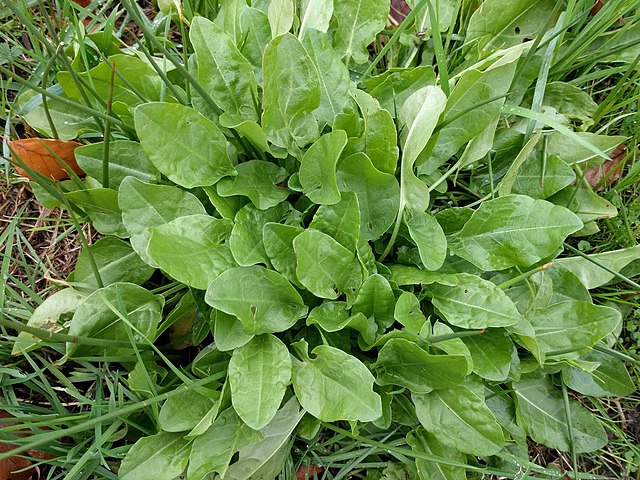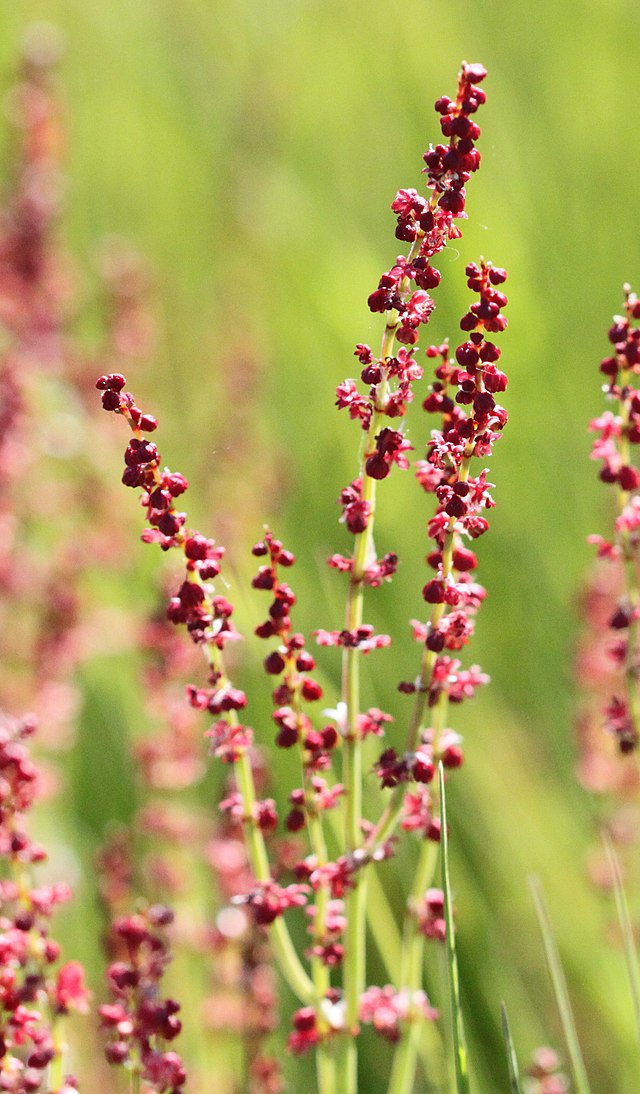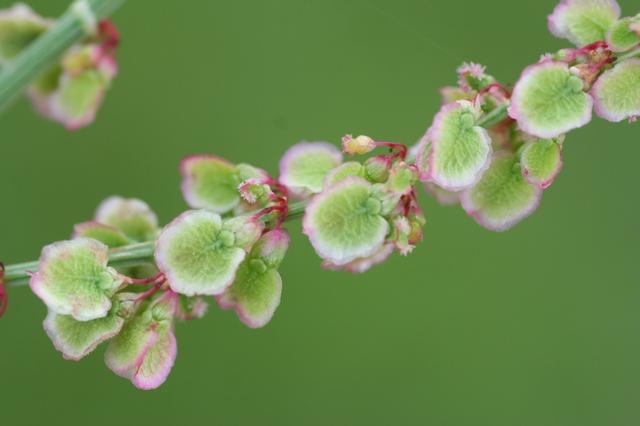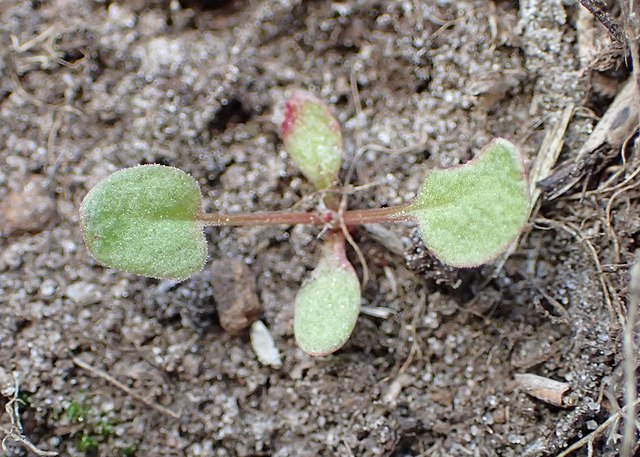Looking for something sour, lemony, and refreshing? Nature has produced just the thing: Sorrel (Rumex acetosa), also called Common Sorrel and Garden Sorrel, one of few perennial salad greens in our climate. It is in the buckwheat (Polygonacea) family and is related to buckwheat (no surprise there) and rhubarb. There are a few different types of cultivated sorrel: garden sorrel, french sorrel, and red-veined sorrel. The most common one used for cooking is french sorrel. POP has dedicated a section of the Learning Orchard at The Woodlands in a partnership with True Love Seeds to grow and save seeds of the ‘Green de Belleville’ variety, which is actually going to seed this time of year (mid-summer). Because it is so easy to start sorrel from seed, it is worthwhile saving the seed from the plant.

Photo credit: Michel Langeveld on Wikimedia Commons
CHARACTERISTICS
This perennial herbaceous plant is a rosette of small leaves on a long leaf stalk. The leaves look like a smaller version of spinach leaves. It grows in a clump and usually stays under a foot tall. It has a deep taproot, which often means a low-maintenance plant that can fend for itself (translation: a deep taproot has a better ability at reaching water). It often bolts (flowers) into a long-stalked, whorled, reddish flower spike, when temperatures begin to soar midsummer. This often results in smaller leaves so if you want to continue harvesting leaves, cut off the flowering stalk. The flowers turn into brown, crunchy seed heads.

Photo credit: Phil Sellens on Wikimedia Commons

Photo credit: Henry Brisse on Wikimedia Commons
HABITAT
Sorrel can be found growing in grassland-like habitats and can tolerate partial shade (though it prefers full sun). It’s easy to grow and can reseed pretty profusely, popping up in larger numbers the following season. This can be prevented by removing the seed heads. Garden sorrel needs more damp soil while french sorrel prefers dry soil.
HARVESTING
Sorrel’s flavor brightens everything it touches, so it’s a good leafy green to have in your kitchen arsenal. It’s lemony, fresh flavor is unparalleled. It is usually ready to harvest in late spring, but can be harvested a second time in the fall, even after it bolts (flowers). There is one cultivated variety called ‘Profusion’ sorrel that never flowers and thus can be harvested all season. Sorrel is ready to eat when the the plant reaches 4 inches tall. The younger leaves are more tender. How does one harvest this plant? It’s similar to how you would harvest spinach. Just cut or tear the leaf stalk from the base of the main stalk gently, being careful not to pull the plant out of the ground. Harvest only what you need at a time and take the outer leaves; this will ensure the plant keeps growing new leaves. Once it bolts, remove the flowering stalk to promote further growth of leaves. You can continue cutting back the flowering stalk into the fall.
CULTIVATION
It’s best to plant sorrel in a sunny spot although they will grow in partial shade as well. Planting from seed is one way to go about it. Dividing clumps is another method. Sow heavily in spring (March-May), and thin out plants to 12 inches apart once they germinate. In the following years, you can divide the clumps so that they are 2 feet apart. The plant is relatively pest free, apart from the leaf miner, which can make the leaves thin and papery. Remove these leaves and dispose of them off site. Once the plant flowers and fruits, you can save seed from it and replant any new seeds the following spring.

Photo credit: Krzysztof Ziarnek on Wikimedia Commons
RECIPES
Sorrel is used widely in French cuisine, but hasn’t really made it into many American recipes. Here are some recipe ideas for any sorrel-lovers out there:
- 4 tablespoons unsalted butter, divided
- 1/2 cup chopped green onions, ramps or other wild onion
- 4-6 cups of chopped sorrel, packed
- Salt
- 3 tablespoons flour or cornstarch
- 1 quart chicken stock or vegetable stock
- 2 egg yolks
- 1/2 cup cream
1.) Melt 3 tablespoons butter in a soup pot over medium heat. Add the green onions or ramps and turn the heat to medium-low. Cover the pot and cook gently for 10 minutes.
2.) While the onions are cooking, pour the stock into another pot and bring to a simmer.
3.) Turn the heat up, add the sorrel leaves and a pinch of salt to the pot with the onions and stir well. When the sorrel is mostly wilted, turn the heat back to medium-low, cover and cook 10 minutes. Stir occasionally. Mix in the flour or cornstarch and cook over medium heat for 3 minutes.
4.) Whisk in the hot stock, stirring constantly. Bring this to a simmer.
5.) To finish the soup, whisk together the egg yolks and cream. Temper the mixture by ladling a little soup into it with one hand, while you whisk the egg-cream mix with the other. Repeat this three times. (You are doing this to prevent the eggs from scrambling) Now start whisking the soup. Pour the hot egg-cream-soup mixture into the pot with the soup, whisking all the way. Add the final tablespoon of butter. Let this cook (below a simmer) for 5 minutes. Do not let it boil or the soup will break.
*Vegan version: replace butter with vegan butter, egg yolk with vegan egg yolk substitute, and cream with coconut cream
- 2 cups loosely packed arugula and sorrel leaves
- 2 medium ripe white peaches, sliced
- 2 tablespoons honey
- 2 tablespoons grape seed oil
- 1 tablespoon balsamic vinegar
- Optional – fresh lemon zest from 1/2 medium lemon
- 1 tablespoon fresh lemon juice
- 1/4 teaspoon vanilla extract
- Salt to tase
- Black pepper
1.) Whisk together dressing ingredients (honey, grapeseed oil, balsamic vinegar, lemon zest (optional), lemon juice, vanilla, salt, & pepper) in bowl.
2.) Tear sorrel into bite sized pieces. Put torn up sorrel leaves and arugula leaves and sliced peaches in large bowl.
3.) Dress with salad with vinaigrette. Top with additional lemon zest if desired.
Try this recipe with sorrel instead of spinach- or a combination of the two!
- 1 tablespoon unsalted butter
- 1/4 cup finely chopped onion
- 1 pound spinach, large stems removed, coarsely chopped
- 1/3 cup heavy cream
- 1 clove garlic, minced
- 1/4 teaspoon grated nutmeg, preferably fresh
- 1/4 teaspoon kosher salt
- Freshly ground black pepper
- 1/3 cup coarsely chopped fresh dill
1.) Melt the butter in large pot over medium heat. Add the onion and cook, stirring often, until soft and translucent, 3 to 5 minutes. Add the spinach, cover, and cook, stirring once or twice, until wilted, 2 to 3 minutes. Using a slotted spoon, transfer the spinach and onions to a bowl. Pour off any liquid left in the pot.
2.) Return the pot to medium heat and add the cream, garlic, and nutmeg. Let the cream come to a low simmer, and cook, stirring often, until it thickens and reduces slightly, 2 to 3 minutes. Stir in the salt and several grinds of pepper.
3.) Give the spinach a squeeze to remove any excess liquid and return it to the pot, tossing to coat it in the reduced cream. Remove the pot from the heat and stir in the dill. Taste and season with more salt or pepper as needed.
*Vegan version: replace butter with vegan butter and heavy cream with coconut cream or 1 cup non-dairy milk and 2 tbsp cornstarch
REFERENCES
https://extension.umn.edu/vegetables/growing-sorrel
thekitchn.com/creamy-spinach-and-dill-257165
honest-food.net/french-sorrel-soup/
whiteonricecouple.com/white-peach-sorrel-salad-balsalmic-vinaigrette/
DISCLAIMER
The information presented on this website is for informational, reference, and educational purposes only and should not be interpreted as a substitute for diagnosis and treatment by a health care professional. Always consult a healthcare professional or medical doctor when suffering from any health ailment, disease, illness, or injury, or before attempting any traditional or folk remedies. Keep all plants away from children. As with any natural product, they can be toxic if misused.
The Philadelphia Orchard Project stresses that you should not consume parts of any wild edible plants, herbs, weeds, trees, or bushes until you have verified with your health professional that they are safe for you. As with any new foods that you wish to try, it is best to introduce them slowly into your diet in small amounts.
This POP Blog was written by Orchard Assistant Simone Shemshedini.
SUPPORT US! If you found this entry useful, informative, or inspiring, please consider a donation of any size to help POP in planting and supporting community orchards in Philadelphia: phillyorchards.org/donate